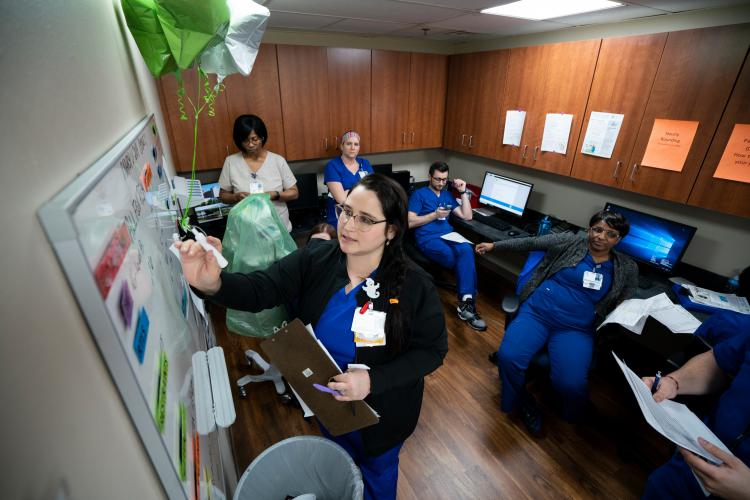
Shift change hand-offs are two of the most important times of the day for both JPS Health Network caregivers and their patients.
The hand-offs, which occur at 6 a.m. and 6 p.m. as nurses’ 12-hour shifts conclude for some and begin for others, are not only critical for keeping team members informed about the health needs of the people they’re caring for. They’re also an excellent opportunity to bring patients into the conversation about their care.
“When the shift change hand-off happens, we like to do it at the patients’ bedside,” explained Tiffany Miller, RN Clinical Manager on the T-5 Surgery Unit. “We want to involve the patient. That’s important because they might have issues that are pertinent but they wouldn’t otherwise bring them up if we didn’t take the time to meet and have a discussion.”
The goal of the hand-off is to make sure all relevant information about patients’ care is passed on to the people coming on duty. But the process also allows the patient an opportunity to ask questions and to meet the person who will be taking care of them for the next 12 hours, developing trust and a rapport.
“While the main goal of the hand-off is patient safety, a bonus feature is that it contributes positively to the patient experience,” Miller said. “A positive environment is proven to be beneficial to the healing process. Besides, we want our patients to know we truly care about them and that we’re there to help them through their concerns.”
Trisha Swift, Vice President and Chief Quality Officer, said excellent communication is one of the most important factors when it comes to patient safety. That’s why it’s so important to have a standardized hand-off procedure in place.
“Communication breakdown is the number one root cause for patient harm events, as reported by The Joint Commission,” Swift said. “Patient care delivery is complex and involves many points of handoff. In fact research indicates that an average medical patient has 25-30 healthcare staff members involved in their care. Therefore, the need for clear, concise, and direct communication is paramount. A standardized communication tool, such as SBAR, creates an easy way to ensure streamlined and clear hand off occurs for every patient, every situation, every time.”
To make sure the hand-off is done correctly every time, JPS team members follow the SBAR process. It’s an acronym that stands for:
Situation: What is going on with the patient and why health care professionals or attention is needed?
Background: Identify and provide the diagnosis or reason for the patient’s admission, their medical status, and history. The background is also the place to determine the reason or context of the patient's visit or situation.
Assessment: What is the problem based on current assessments and medical findings.
Recommendation: provide an explicit statement of what is required, how urgent, and what action needs to be take.
“Our hand-off process has evolved over the years,” Miller said, noting that each nurse on T-5 typically has 5-6 patients under their care at one time who they must transition to the person who comes in to relieve them. “The SBAR formula helps us created a standardized process that our nurses are comfortable with and confident it. A successful hand-off is key to beginning a successful shift.”
